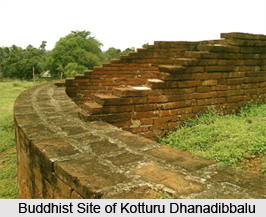 Kotturu Dhanadibbalu and Pandavula Guha is a reputed Buddhist archaeological site, enriched with ancient Buddhist relics. It is located in the southern Indian state of Andhra Pradesh, particularly near Kotturu village in Rambilli mandal, which is based in the district of Vishakhapatnam. The city of Vishakhapatnam was named after the god of `Valor-Vishakha`. Vishakhapatnam was a part of the Kalinga Kingdom, under Ashoka`s rule in 260 B.C. It passed on later to the Andhra Kings of `Vengi`. After this Pallava, Chola and Ganga dynasties ruled the city. In the 15th century, Vishakhapatnam became a part of the Vijayanagar Empire.
Kotturu Dhanadibbalu and Pandavula Guha is a reputed Buddhist archaeological site, enriched with ancient Buddhist relics. It is located in the southern Indian state of Andhra Pradesh, particularly near Kotturu village in Rambilli mandal, which is based in the district of Vishakhapatnam. The city of Vishakhapatnam was named after the god of `Valor-Vishakha`. Vishakhapatnam was a part of the Kalinga Kingdom, under Ashoka`s rule in 260 B.C. It passed on later to the Andhra Kings of `Vengi`. After this Pallava, Chola and Ganga dynasties ruled the city. In the 15th century, Vishakhapatnam became a part of the Vijayanagar Empire.
Kotturu Dhanadibbalu is situated on the banks of Sarada River and it is referred to as `Dhanadibbalu` by the regional inhabitants of Vishakhapatnam District. Kotturu Dhanadibbalu is existent at a distance of nearly 8 km away from Yelamanchili town, which is present near Atchutapuram.
Archaeological Remnants at Kotturu Dhanadibbalu
Remnants of an old Buddhist `vihara` and a `Maha Stupa` are present at Kotturu Dhanadibbalu, apart from a tiny part of rock-cut cave which was utilized by Buddhist monks during 1st century BC, till the 2nd century BC. The rock cut caves are situated on the lush green hilly slopes which lie here, along the river banks of Sarada. Minor rock edicts and several other archaeological remains have been unearthed from this site by the excavations conducted under the supervision of the archaeology department.
Near the Maha Stupa is present some small rock cisterns, which are located at the entrance of the hilly regions. From a distance, ruins of scattered bricks and the vihara are also visible, and the rock-cut caves can also be accessed. This area is also known as `Pandavula Guha` since it resembles the number of accommodations in this cave, which consists of five portions. Currently, numerable bricks belonging to the Maha Stupa and also the vihara are employed by the regional residents of this place as they are unaware about the significance of this beautiful heritage site and also due to the absence of official vigilance. Today, the archaeology department has surrounded the site with a fence and has established a sign board at the site.



















